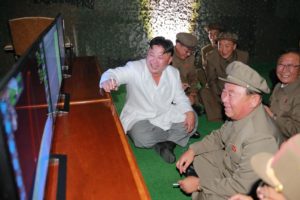
Washington Post:
North Korea leader Kim Jong Un crowed about “the greatest success” of a ballistic missile launched from a submarine this week, which appeared to be a major technological breakthrough for the nuclear-armed regime.
After a series of flops, North Korea launched a missile from a submarine near its east coast port of Sinpo early Wednesday. It flew about 300 miles before falling into the sea inside Japan’s air defense identification zone, the area in which Tokyo controls aircraft movement.
The launch, apparently of a KN-11 or “North Star” missile, contravenes U.N. resolutions and was roundly condemned by Japan, South Korea and China, as well as by the United States and the United Nations.
But in North Korea’s state media Thursday, the apparently successful launch was cause for major celebration. The Rodong Sinmun, the mouthpiece of the ruling Workers’ Party, carried seven color photos on its front page Thursday, including a large one of Kim surrounded by military officials, all of them smiling broadly.
Such images are used in North Korean propaganda in an effort to convince the populace, who have little, if any, access to outside information, that their impoverished and technologically backward country is strong and standing up to a United States that, the state media say, is trying to destroy North Korea.
Kim lauded the missile launch as “a great manifestation and demonstration of the tremendous power and inexhaustible muscle,” according to the state-run Korean Central News Agency.
North Korea has “joined the front rank of the military powers fully equipped with nuclear attack capability,” and the U.S. mainland is now within North Korea’s striking range, he said.
The missile was launched at a steep angle, a South Korean military source told Yonhap News Agency in Seoul, meaning it likely could have traveled for more than 600 miles if it had been fired at a regular angle.
The launch coincided with the start of annual drills between the South Korean and American militaries, exercises that always elicit an angry reaction from the North, which views them as a pretext for an invasion. The young North Korean leader came out with another round of bluster Thursday.
“I do not guess what ridiculous remarks the U.S. and its followers will make about this test-fire, but I can say their rash acts will only precipitate their self-destruction,” Kim reportedly said. “The best way of escaping the deadly strike of the infuriated KPA [Korean People’s Army] is to refrain from hurting the dignity and security of [North Korea] with prudence and self-control.”
Pyongyang had been threatening to vent its fury over the exercises — and over South Korea’s decision to host a U.S. anti-missile unit — so Wednesday’s launch did not exactly come as a surprise.
The military has also clearly been trying to advance its ballistic missile program, conducting a series of land- and sea-based tests over the last year. It appears to be trying to work on its intermediate-range Musudan missile, which can theoretically reach Guam, and its submarine-launched missiles, which would give it the ability to stage an attack from sea.
The tests have had a patchy record of success. The most recent KN-11 launches — three in the last year — were all deemed failures because the missiles exploded at launch or traveled only a short distance.
But analysts say that even failures offer lessons for North Korea’s rocket scientists.
Joseph S. Bermudez, a military analyst affiliated with the Washington-based U.S.-Korea Institute at SAIS, said this week’s test showed that North Korea remains strongly committed to the long-term development of an operational submarine-launched ballistic missile (SLBM) and is learning from its previous successes and failures.
“The North is demonstrating a nascent capability to strike at South Korea with an SLBM, thereby complicating ballistic missile defense planning and operations,” Bermudez said in a commentary posted on the 38 North website.
“Assuming the current rate of development, while North Korea still faces significant technological challenges including building a new class of submarine to carry the missile, it is on track to develop the capability to strike targets in the region — including Japan — by 2020.”
